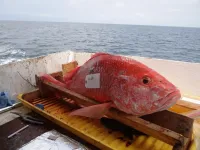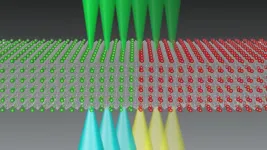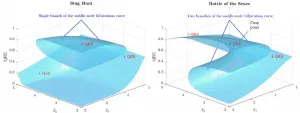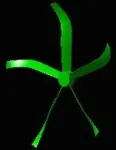In decision-making, biases are an unconscious tendency that are difficult to eradicate
This is according to a study conducted in primates, published in Current Biology, led by Ruben Moreno Bote and Gabriela Mochol, researchers at the Center for Brain and Cognition, in collaboration with Roozbeh Kiani, a researcher at New York University
2021-03-10
(Press-News.org) ften, humans display biases, i.e., unconscious tendencies towards a type of decision. Despite decades of study, we are yet to discover why biases are so persistent in all types of decisions. "Biases can help us make better decisions when we use them correctly in an action that has previously given us great reward. However, in other cases, biases can play against us, such as when we repeat actions in situations when it would be better not to", says Rubén Moreno Bote, coordinator of the UPF Theoretical and Cognitive Neuroscience Laboratory.
In these cases, decisions are guided by tendencies, or inclinations, that do not benefit our wellbeing. For example, playing the lottery more regularly after winning a small consolation prize is a common bias that unfortunately does not tend to improve our financial situation.
The aim of the research was to establish how biases arise in decision-making using mathematical models and neural recordings
A study led by professor Rubén Moreno Bote's laboratory, with Grabriela Mochol, researchers at the Center for Brain and Cognition (CBC) at the UPF Department of Information and Communication Technologies (DTIC), in collaboration with the experimental laboratory of professor Roozbeh Kiani of New York University (USA), has studied how biases arise in decision-making using mathematical models and neural recordings in primates. The study was published by the authors on 26 February in the journal Current Biology.
A task dealing with the perception of visual stimuli
The experimental block of the study consisted of a visual perception task in which a monkey observed a certain stimulus, specifically moving dots. The primate had to decide whether there were more dots moving to the right or to the left. Trial after trial, the animal performed this monotonous decision-making process.
The authors found that primate developed two types of bias: a "slow" tendency to indicate right (or left) that lasted several minutes, despite not having any net tendency in the set of stimuli used, and a "fast" tendency that lasted scarcely a few seconds, resulting from the actions had just been made in the previous decision.
The neural representation of biases is similar to the neural representation of relevant information for solving a certain task
"For this research, we study how the prefrontal cortex, which is crucial in decision-making, encodes the two identified biases (slow and fast). The main result of the study shows that the neural representation of biases is similar to the neural representation of relevant information for solving a certain task. This would seem to indicate that the format in which biases and information are coded in the brain are very similar, so similar that it is difficult to distinguish them", points out Moreno Bote, study principal investigator.
And he adds: "We still have much to understand, but the results of this research could explain why biases are so prevalent in decision-making, and why, much to our regret, they are so difficult to eradicate".
INFORMATION:
Related work:
Gabriela Mochol, Roozbeh Kiani, Rubén Moreno Bote (2021) "Prefrontal cortex represents heuristics that shape choice bias and its integration into future behavior", Current Biology, 26 february. DOI:https://doi.org/10.1016/j.cub.2021.01.068
[Attachments] See images for this press release:
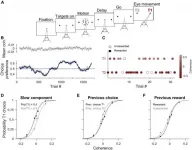
ELSE PRESS RELEASES FROM THIS DATE:
2021-03-10
Recent studies estimate that we use an astounding 129 billion face masks globally every month - that is 3 million a minute. Most of them are disposable face masks made from plastic microfibers.
- With increasing reports on inappropriate disposal of masks, it is urgent to recognize this potential environmental threat and prevent it from becoming the next plastic problem, researchers warn in a comment in the scientific journal Frontiers of Environmental Science & Engineering.
The researchers are Environmental Toxicologist Elvis Genbo Xu from University of Southern Denmark and Professor of Civil and Environmental Engineering ...
2021-03-10
Global targets to improve the welfare of people across the planet will have mixed impacts on the world's forests, according to new research.
The United Nations' 17 key areas for global development - known as the Sustainable Development Goals (SDGs) - range from tackling poverty, hunger and sanitation to promoting clean energy, economic growth and reducing inequality.
Many of these goals, such as improved peace and justice, good health and wellbeing, and quality education, will have a positive impact on the Earth's natural forests.
But others, including creating new roads, industry and infrastructure, ...
2021-03-10
Nearly 100 percent of the red snapper sampled in the Gulf of Mexico over a six-year period by University of South Florida (USF) marine scientists showed evidence of liver damage, according to a study reported in Aquatic Toxicology.
The study is the first to correlate the concentration of crude oil found in the workhorses of the digestive system -- the liver, gall bladder, and bile - with microscopic indicators of disease, such as inflammation, degenerative lesions, and the presence of parasites. The team sampled nearly 570 fish from 72 Gulf locations between 2011 to 2017 in the wake of the historic 2010 Deepwater Horizon oil spill.
"The results add to the list of other species we've analyzed indicating early warning ...
2021-03-10
In a breakthrough for quantum computing, University of Chicago researchers have sent entangled qubit states through a communication cable linking one quantum network node to a second node.
The researchers, based in the Pritzker School of Molecular Engineering (PME) at the University of Chicago, also amplified an entangled state via the same cable first by using the cable to entangle two qubits in each of two nodes, then entangling these qubits further with other qubits in the nodes.
The results, published February 24, 2021 in Nature, could help make quantum computing more feasible and could lay the groundwork for future quantum communication networks.
"Developing methods that ...
2021-03-10
"Phase transitions" are a central phenomenon in physical sciences. Despite being technical-sounding, they are actually something we all experience in everyday life: ice melting into liquid water, or hot water evaporating as steam. Solid, liquid, and gas are three well known "phases" and, when one turns into another, that is a phase transition.
Rare-earth nickelate oxides, also called nickelates, have attracted a lot of interest from researchers because they display an electronic phase transition, which may be exploited in future electronic devices. This particular phase transition consists of turning from a metallic ...
2021-03-10
Game theory is known to be a useful tool in the study of Machine Learning (ML) and Artificial Intelligence (AI) Multi-Agent interactions.
One basic component of these ML and AI systems is the exploration-exploitation trade-off, a fundamental dilemma between taking a risk with new actions in the quest for more information about the environment (exploration) and repeatedly selecting actions that result in the current maximum reward or (exploitation).
However, the outcome of the exploration-exploitation process is often unpredictable in practice and ...
2021-03-10
The balance of human intestinal microbiota, consisting of hundreds of bacterial species and phages (bacteria viruses), is crucial to good health. A research team, including scientists from the CNRS* and the Institut Pasteur, has characterised the phage-bacterial interaction networks of the microbiota in ten healthy individuals, with unprecedented precision. Scientists detected several hundred bacterial and phage genomes and identified the thousands of interactions that bind them by quantifying the contacts between the DNA molecules of viruses and their hosts. This method has the advantage ...
2021-03-10
Researchers have published a study revealing their successful approach to designing much quieter propellers.
The Australian research team used machine learning to design their propellers, then 3D printed several of the most promising prototypes for experimental acoustic testing at the Commonwealth Scientific and Industrial Research Organisation's specialised 'echo-free' chamber.
Results now published in Aerospace Research Central show the prototypes made around 15dB less noise than commercially available propellers, validating the team's design methodology.
RMIT University aerospace engineer and lead researcher Dr Abdulghani Mohamed said the impressive results were enabled by two key innovations - the numerical algorithms ...
2021-03-10
Researchers at the University of Alabama at Birmingham have identified a new molecular target that could potentially treat the deadly, aging-related lung disease idiopathic pulmonary fibrosis (IPF). The study, which will be published March 10 in the Journal of Experimental Medicine (JEM), suggests that targeting a protein called MDM4 could prevent respiratory failure by initiating a genetic program that removes scar tissue from the lungs.
IPF is characterized by the accumulation of scar tissue that stiffens the lungs and makes it difficult for patients to breathe and get sufficient oxygen into their blood. Though the causes of IPF remain unclear, age is a significant risk factor: the disease is ...
2021-03-10
Blood pressure measurements in children and adolescents should be taken from both arms after new research showed substantial differences could be seen depending on which arm was used.
The study, led by the Murdoch Children's Research Institute (MCRI) and published in the Journal of Hypertension, found even a small difference in blood pressure measurements between arms could lead to a wrong diagnosis.
MCRI PhD candidate and study lead author Melanie Clarke said this was the first study worldwide to determine the size and frequency of inter-arm blood pressure differences in children and adolescents.
The study involved ...
LAST 30 PRESS RELEASES:
[Press-News.org] In decision-making, biases are an unconscious tendency that are difficult to eradicate
This is according to a study conducted in primates, published in Current Biology, led by Ruben Moreno Bote and Gabriela Mochol, researchers at the Center for Brain and Cognition, in collaboration with Roozbeh Kiani, a researcher at New York University


